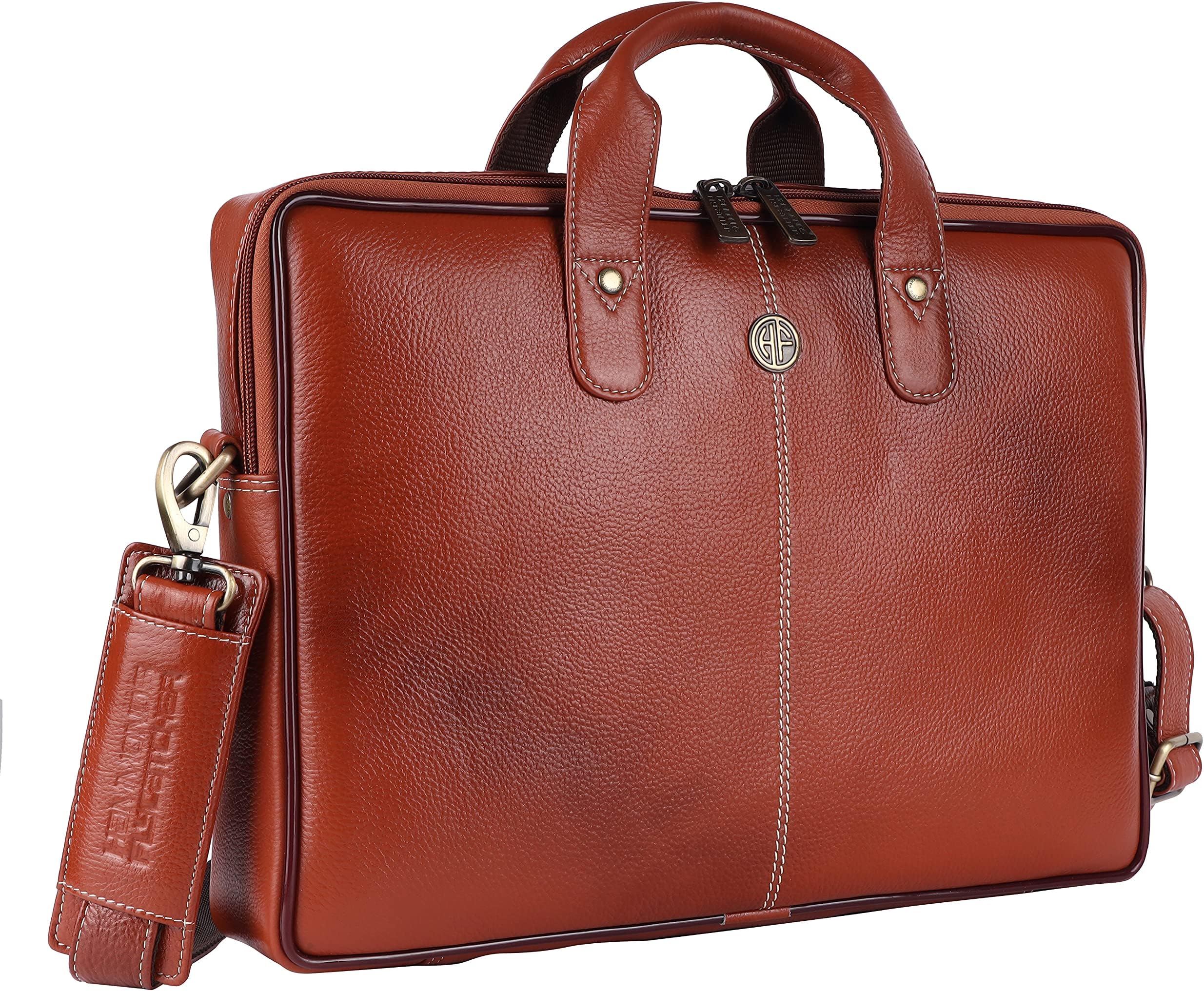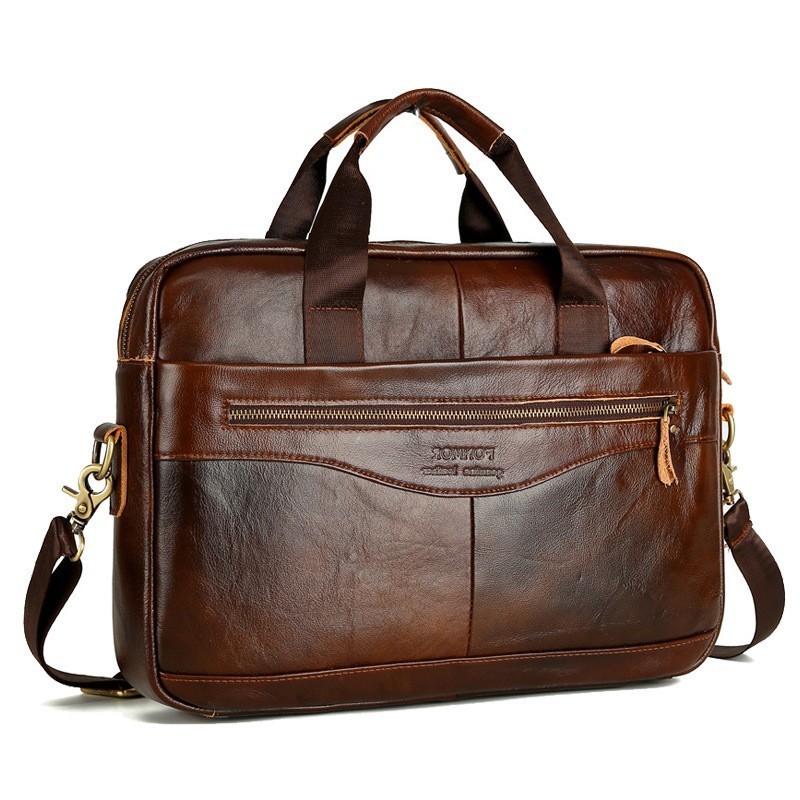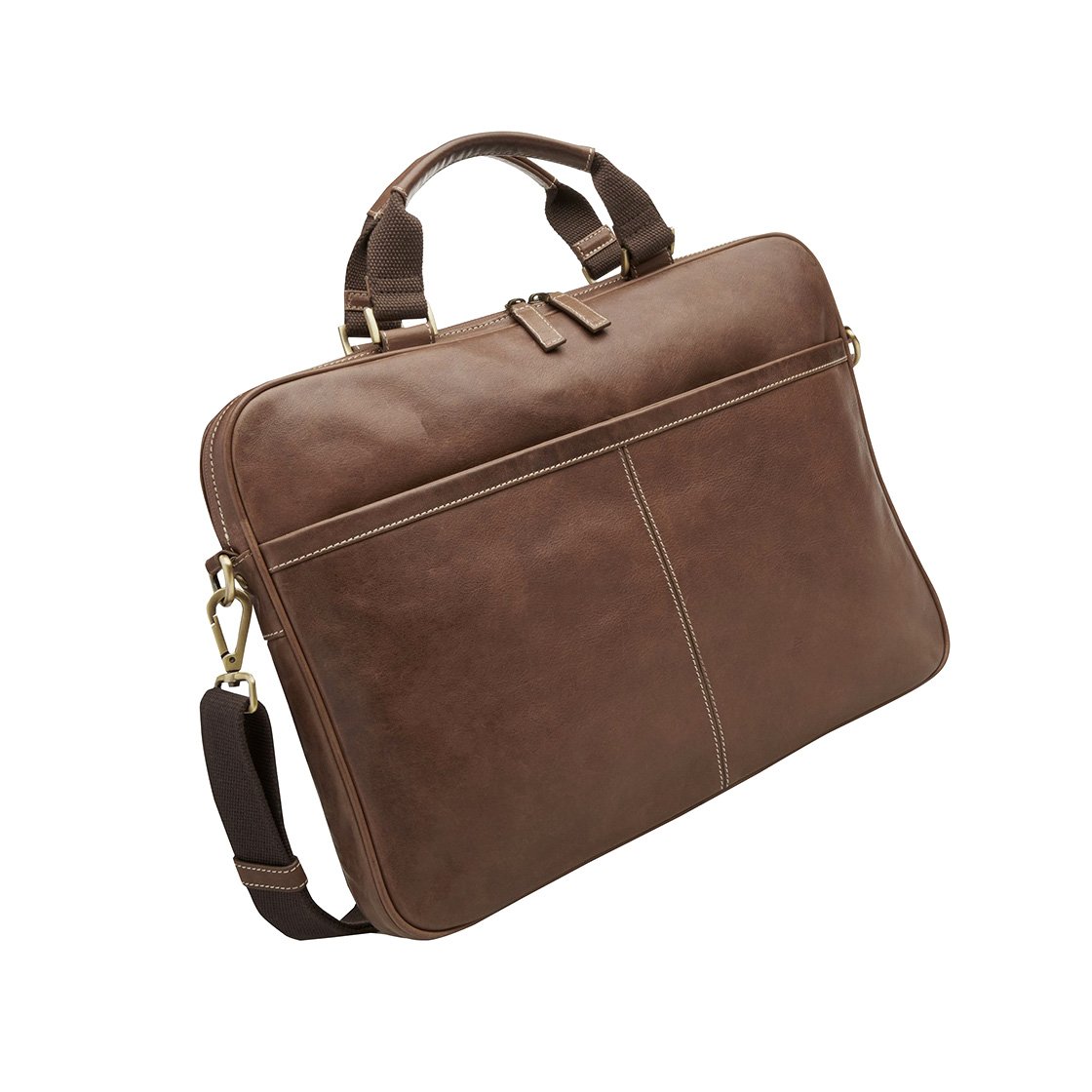Choosing a men’s leather laptop bag involves assessing leather quality, style, and function. Prioritize full-grain leather for durability and a professional look.

Table of Contents
- What Defines a Professional Leather Laptop Bag?
- Decoding Leather Quality: What Should You Look For?
- Which Style Suits Your Professional Needs?
- Assessing Functionality and Practical Design
- Why Craftsmanship and Durability Matter
- Selecting the Right Size for Your Devices
- A Final Check on Essential Details

What Defines a Professional Leather Laptop Bag?
A professional laptop bag is more than just a utility item; it is an extension of your professional identity. It signals attention to detail, an appreciation for quality, and a commitment to presenting yourself with poise and confidence. Unlike casual bags, a professional leather bag features a structured silhouette, clean lines, and a sophisticated finish that complements business attire, from sharp suits to business-casual ensembles. It is an investment in your personal brand.

The right bag balances timeless aesthetics with modern functionality. It should look just as appropriate in a high-stakes boardroom meeting as it does during a client lunch or while navigating a busy airport. The material, color, and hardware all contribute to its overall impression. A premium leather bag, for instance, develops a unique patina over time, telling a story of your career journey and becoming a trusted companion that ages as gracefully as your professional experience grows.
Decoding Leather Quality: What Should You Look For?
The term “leather” encompasses a wide range of materials with vastly different levels of quality, durability, and appearance. Understanding these distinctions is the most critical step in selecting a bag that will last. The type of leather hide and its treatment process directly impact the bag’s longevity and how it will wear over the years. For a true long-term investment, discerning the grade of the leather is paramount.
Full-Grain Leather: The Gold Standard
Full-grain leather is the highest quality leather available. It comes from the top layer of the hide and includes all of the natural grain, with its inherent imperfections and textures. This material is exceptionally strong and durable because the dense fiber structure of the original grain remains intact. Over time, instead of wearing out, full-grain leather develops a rich patina—a desirable sheen and character that cannot be replicated. At Beldtura Leather, we build our bags exclusively with full-grain leather, ensuring every piece is a testament to enduring quality and timeless style.
Top-Grain Leather: A Balanced Alternative
Top-grain leather is the second-highest grade. It is created by splitting the top layer of the hide and sanding away any imperfections. While this process makes the surface more uniform and stain-resistant, it also removes the strongest fibers. Top-grain is still a durable and high-quality option, but it will not develop the same robust patina as full-grain leather and may feel slightly less premium to the touch.
Understanding “Genuine” and Bonded Leather
The term “genuine leather” can be misleading. While it is technically real leather, it is made from the lower layers of the hide that are left after the top layers are split off for higher-grade leathers. It is often corrected with artificial grain patterns and coatings. Bonded leather is at the bottom of the quality spectrum, created from leather scraps and dust that are shredded and bonded together with polyurethane or latex. Both options lack the durability, strength, and character of full-grain or top-grain leather and are not recommended for a professional bag intended for long-term use.
| Leather Type | Description | Durability | Appearance |
|---|---|---|---|
| Full-Grain | Top layer of the hide with natural grain intact. | Highest | Develops a rich patina; unique character. |
| Top-Grain | Top layer is sanded to remove imperfections. | High | Uniform, smooth finish. |
| Genuine | Lower-quality layers of the hide. | Moderate | Often has an artificial grain applied. |
| Bonded | Leather scraps bonded with adhesive. | Low | Plastic-like and prone to peeling. |
Which Style Suits Your Professional Needs?
The style of your laptop bag should align with your work environment, daily commute, and personal taste. Each design offers a distinct blend of formality, comfort, and accessibility. Consider what you carry daily and how you move throughout your workday to determine the best fit.
The Classic Leather Briefcase
The briefcase is the quintessential symbol of professionalism. Its structured design, top handles, and clean profile make it the ideal choice for corporate environments, law firms, and financial institutions. Modern briefcases, like the Beldtura Leather Atticus Briefcase, offer dedicated laptop sleeves and smart organizational pockets while retaining their timeless, authoritative look. A briefcase is best for those who want to project a formal, polished image and typically carry documents alongside their tech.
The Versatile Leather Messenger Bag
A messenger bag offers a perfect blend of professional and casual. Worn over the shoulder or across the body, it provides hands-free convenience, making it ideal for commuters who walk, bike, or use public transportation. A high-quality leather messenger bag maintains a professional aesthetic while offering easy access to your belongings. It is a superb choice for creative professionals, consultants, and academics who require functionality without sacrificing style.
The Modern Leather Backpack
Once relegated to schoolyards, the leather backpack has evolved into a sophisticated option for the modern professional. It distributes weight evenly across both shoulders, making it the most ergonomic choice for those who carry heavy loads or travel frequently. A sleek, minimalist leather backpack in a dark, neutral color can be perfectly appropriate for many contemporary offices, especially in the tech and creative industries. Look for designs with a streamlined profile to maintain a professional appearance.
Assessing Functionality and Practical Design
A great professional bag is not just about looks; its interior design is equally important. True functionality comes from thoughtful details that protect your devices and keep you organized throughout the day. When inspecting a bag, pay close attention to its internal layout and the quality of its components.
Padded Laptop Compartments
The primary function of a laptop bag is to protect your computer. A dedicated, well-padded laptop compartment is non-negotiable. This sleeve should be sized appropriately for your device to prevent it from shifting during transit. Check for soft, non-abrasive lining and sufficient cushioning on all sides, especially the bottom. Some premium bags also feature a false bottom, where the sleeve is suspended slightly above the bag’s base for added drop protection.
Smart Organization and Pockets
An organized bag saves you time and reduces stress. Look for a layout that includes specific pockets for your essentials:
- Slots for pens, business cards, and your phone.
- A zippered interior pocket for valuable items like keys or a wallet.
- Compartments or dividers to separate documents and notebooks from chargers and cables.
- An easily accessible external pocket for items you need to grab quickly.
A well-designed bag ensures everything has its place, preventing a cluttered main compartment.
Quality of Hardware: Zippers, Buckles, and Clasps
The hardware is a frequent point of failure on poorly made bags. High-quality hardware not only enhances the bag’s appearance but also ensures its longevity. Look for zippers from reputable brands like YKK, which are known for their smoothness and durability. Test the buckles, clasps, and magnetic snaps to ensure they are secure and easy to operate. Solid brass or stainless steel hardware is far superior to cheaper plated metals that can chip, tarnish, or break.
Why Craftsmanship and Durability Matter
Superior materials are only part of the equation; expert craftsmanship brings them together to create a product that can withstand the rigors of daily use. The construction of a bag reveals the maker’s commitment to quality. Inspect the details closely, as they are a clear indicator of how the bag will perform over time.
The Importance of Stitching and Lining
Check the stitching along the seams, handles, and strap anchor points. It should be tight, straight, and consistent. Uneven or loose threads are a sign of poor quality control. A durable bag will often feature reinforced stitching in high-stress areas. The interior lining is also important. A sturdy, tear-resistant fabric like canvas or a high-quality synthetic blend will protect your belongings and withstand wear better than a thin, flimsy material.
Handle and Strap Construction
The handles and shoulder strap bear the most weight. Rolled leather handles are comfortable to hold and extremely durable. Ensure they are securely attached to the body of the bag, preferably with both stitching and metal rivets. If the bag includes a shoulder strap, check that it is adjustable, comfortable, and made from a durable material—ideally leather or thick-webbed canvas with leather accents. The points where the strap connects to the bag should be robustly reinforced.
Selecting the Right Size for Your Devices
Choosing the correct size is a practical necessity. A bag that is too small for your laptop is useless, while one that is too large can be cumbersome and allow your devices to shift around, risking damage. Before you shop, measure your laptop’s screen size (diagonally) as well as its physical width and depth.
Compare these dimensions to the bag’s listed specifications for its laptop compartment. Remember to account for everything else you carry daily. Will you need space for a charger, a mouse, a tablet, a water bottle, or a portfolio? Lay out all your daily essentials to visualize the capacity you need. This ensures you select a bag that accommodates your technology and other items comfortably without being overstuffed or unnecessarily bulky.
A Final Check on Essential Details
With the major considerations covered, a few final details can help you make the perfect choice. These elements contribute to the bag’s overall usability and aesthetic harmony with your professional wardrobe.
Color and Finish
For a professional setting, classic colors are always a safe and stylish bet. Black, dark brown, and tan are versatile choices that pair well with nearly all business attire. Black offers a formal, modern look, while brown and tan shades provide a warmer, more traditional feel that highlights the leather’s natural character. Consider your primary shoe and belt colors to create a cohesive professional look.
Weight and Comfort
A leather bag, especially one made from full-grain leather, will have some inherent weight. Consider this baseline weight and add the weight of your typical daily carry. If you have a long commute or travel often, the bag’s empty weight can be a significant factor. An ergonomic design, a padded shoulder strap, and well-balanced construction can make a heavier bag feel more comfortable to carry.



